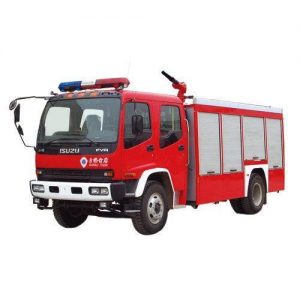Description
FIRE FIGHTING TRUCK
Quartz, 7 Dec. 2022 Minutes later another cruiser drives by, followed by an EMT truck, a fire truck with lights flashing and more police cruisers speeding by. — Brad Schrade, ajc, 9 May 2020 Sixty-mile-per-hour gusts peeled back the door on a fire truck. —
These example sentences are selected automatically from various online news sources to reflect current usage of the word ‘fire truck.’ Views expressed in the examples do not represent the opinion of Merriam-Webster or its editors.
An early device used to squirt water onto a fire is a squirt or fire syringe. Hand squirts and hand pumps are noted before Ctesibius of Alexandria invented the first fire pump circa the 2nd century B.C.,[1] and an example of a force-pump possibly used for a fire-engine is mentioned by Heron of Alexandria. The fire pump was reinvented in Europe during the 16th century, reportedly used in Augsburg in 1518 and Nuremberg in 1657. A book of 1655 inventions mentions a steam engine (called a fire engine) pump used to “raise a column of water 40 feet [12.2 m]”, but there was no mention of whether it was portable.
Colonial laws in America required each house to have a bucket of water on the front stoop during fires at night. These buckets were intended for use by the initial bucket brigade that would supply the water at fires. Philadelphia obtained a hand-pumped fire engine in 1719, years after Lynn‘s 1654 model appeared there, made by Joseph Jencks, but before New York’s two engines arrived from London.
By 1730, Richard Newsham, in London, had made successful fire engines; the first used in New York City (in 1731) were of his make (six years before formation of the NYC volunteer fire department). The amount of manpower and skill necessary for firefighting prompted the institution of an organized fire company by Benjamin Franklin in 1737. Thomas Lote built the first fire engine made in America in 1743. These earliest engines are called hand tubs because they are manually (hand) powered and the water was supplied by bucket brigade dumped into a tub (cistern) where the pump had a permanent intake pipe. An important advancement around 1822 was the invention of an engine which could draft water from a water source doing away with the bucket brigade. Philadelphia fire engine manufacturers Sellers and Pennock model the Hydraulion is said to be the first suction engine produced in 1822.[2] Some models had the hard, suction hose fixed to the intake and curled up over the apparatus known as a squirrel tail engine.
The earliest engines were small and were carried by four men or mounted on skids and dragged to a fire. The earliest four-wheel carriage mounted engines were pulled to the fire by hand. As the engines grew larger they became horse-drawn and later self-propelled by steam engines. John Ericsson is credited with building the first American steam-powered fire engine. John Braithwaite built the first steam fire-engine in Britain.
Until the mid-19th century, most fire engines were maneuvered by men, but the introduction of horse-drawn fire engines considerably improved the response time to incidents. The first self-propelled steam-driven fire engine was built in New York in 1841. It was the target of sabotage by firefighters and its use was discontinued, and motorized fire engines did not become commonplace until the early 1900s. The dawn of the 20th Century brought about the age of the motorized fire apparatus. One of the first self-propelled fire engines of that era was introduced in 1903 for the Niagara Engine Company of New London, Connecticut,.[3] It was driven by a steam-powered engine, as opposed to an internal combustion engine which proved to be more popular. By 1905, the idea of combining gasoline engine motor trucks into fire engines was attracting great attention; according to a Popular Mechanics article in that year,[4] such trucks were rapidly gaining popularity in England. That same year, the Knox Automobile Company of Springfield, Massachusetts began selling what some[5] have described as the world’s first modern fire engine. A year later, the City of Springfield had an entire modern fire department supplied with Knox fire engines. In 1906, the Waterous Company introduced a fire engine with two gasoline-powered engines, one for propulsion and the other for pumping.[6]
For many years firefighters sat on the sides of the fire engines, or even stood on the rear of the vehicles, exposed to the elements. This arrangement was uncomfortable and dangerous (some firefighters were thrown to their deaths when their fire engines made sharp turns), and today nearly all fire engines have fully enclosed seating areas for their crews.






Reviews
There are no reviews yet.